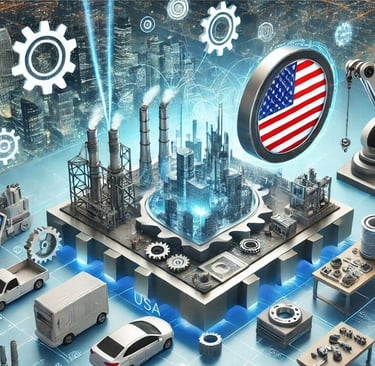Let us collaborate to foster global growth and development together.
How Technology is Transforming the Manufacturing Sector in the USA
Explore how cutting-edge technology is reshaping manufacturing in the USA. From automation to IoT, learn the opportunities driving industry growth
USA
10/31/20243 min read


How Technology is Transforming the Manufacturing Sector in the USA
Meta Description: Explore how cutting-edge technology is reshaping manufacturing in the USA. From automation to IoT, learn the opportunities driving industry growth.
In recent years, technology has revolutionized the manufacturing sector in the USA, bringing profound changes that drive efficiency, innovation, and sustainability. As businesses aim to stay competitive, they are increasingly adopting technologies such as automation, IoT, and AI. Let’s dive into the key advancements shaping American manufacturing and what they mean for the industry’s future.
Why Technology Matters in Manufacturing
Technology isn’t just a competitive advantage anymore; it’s a necessity. In the face of rising labor costs, global competition, and demands for sustainable practices, manufacturers are embracing tech solutions to remain resilient. Advanced technology allows businesses to streamline operations, boost productivity, and meet ever-changing customer demands.
By integrating technology, the USA is not just leading innovation—it’s setting a global benchmark in manufacturing excellence.
The Pillars of Transformation in Manufacturing
Automation and Robotics
Automation has been a game-changer for American factories. From assembly lines to warehouses, robots are taking over repetitive and labor-intensive tasks, allowing human workers to focus on higher-value responsibilities. For example, Tesla utilizes advanced robotics in their manufacturing plants, which speeds up production while maintaining precision.
The introduction of collaborative robots (cobots) is making automation more accessible for small- to medium-sized manufacturers. Unlike traditional robots, cobots work alongside humans, providing flexibility and enhancing worker safety.
Key Benefits of Automation
Improved Efficiency: Automated systems run 24/7, increasing output while reducing downtime.
Cost Reduction: Over time, automation lowers labor and operational costs significantly.
Enhanced Quality Control: Robots deliver consistent precision, minimizing product defects.
The Rise of IoT (Internet of Things)
Smart factories are no longer a futuristic concept. IoT enables machines, devices, and systems to communicate with one another, creating a connected ecosystem. Real-time data from sensors can help manufacturers predict equipment failures, optimize supply chains, and improve product quality.
For example, General Electric (GE) uses IoT-powered systems in its manufacturing plants to track performance, energy usage, and maintenance needs. This proactive approach minimizes disruptions and maximizes efficiency.
How IoT Benefits Manufacturing
Predictive Maintenance: IoT sensors detect equipment issues before they lead to breakdowns, saving time and repair costs.
Inventory Management: IoT provides real-time visibility into stock levels, preventing overproduction or shortages.
Energy Efficiency: Data-driven insights allow businesses to reduce energy consumption, lowering costs and environmental impact.
Artificial Intelligence and Machine Learning
AI and machine learning are no longer exclusive to tech giants—they’re powering the next wave of manufacturing transformation. From supply chain optimization to production forecasting, AI tools analyze vast amounts of data to deliver actionable insights.
For instance, manufacturers use AI to design production schedules that maximize throughput while minimizing waste. With tools like digital twins, companies can simulate their processes to identify inefficiencies without risking disruption to actual operations.
Real-Life Application
Ford: By employing machine learning, Ford improves its assembly line operations, reduces defects, and creates personalized customer experiences.
Boeing: Boeing leverages AI to analyze production data and predict aircraft part failures before they occur, ensuring safety and reliability.
Challenges Manufacturers Face in Adopting Technology
While the benefits of technology are undeniable, integrating it into manufacturing operations isn’t without obstacles:
High Initial Investment: The upfront costs of deploying robotics, IoT, or AI systems can deter smaller manufacturers.
Skill Gaps: A lack of skilled workers to operate and maintain new systems is a persistent issue. Upskilling employees is critical but time-consuming.
Cybersecurity Risks: As factories become more connected, they’re also more vulnerable to cyberattacks, making data security a top priority.
Overcoming these challenges requires strategic investment, partnerships with tech providers, and fostering a culture of continuous learning among employees.
Emerging Trends to Watch
Sustainability
Sustainable manufacturing is no longer optional. Companies are leveraging technology to track carbon emissions, optimize energy use, and recycle waste materials. Green tech innovations such as 3D printing and renewable energy integration are reshaping how products are made.
Additive Manufacturing
Additive manufacturing, or 3D printing, is creating customized solutions at unprecedented speeds. From aerospace to healthcare, manufacturers are using 3D printing for rapid prototyping and small-batch production, drastically reducing time to market.
Workforce Evolution
As automation and AI take over routine tasks, the manufacturing workforce is evolving. Jobs now require advanced technical skills, leading manufacturers to partner with universities and training programs to prepare the workforce for Industry 4.0.
Success Stories: How Businesses Are Thriving
Numerous companies are reaping the rewards of integrating technology into their manufacturing operations. For example:
Procter & Gamble: The company utilizes IoT systems to optimize production lines, reducing waste and enhancing product consistency.
SpaceX: By adopting additive manufacturing, SpaceX rapidly develops rocket components, cutting costs and accelerating innovation.
These examples showcase how embracing technology drives efficiency, creativity, and profitability.
Conclusion: Seizing the Opportunities Ahead
Technology is transforming the manufacturing sector in the USA, opening new possibilities for businesses of all sizes. From automation to IoT, these innovations promise greater efficiency, sustainability, and competitiveness. However, success requires proactive adaptation, investment in skills, and a commitment to leveraging the latest advancements.
Are you ready to embrace the future of manufacturing? Let us know your thoughts or explore related articles like “The Role of IoT in Modern Manufacturing” and “Sustainable Practices in U.S. Factories” for more insights. Together, we can navigate this technological revolution and shape a brighter future for the industry.
Innovation
Cutting-edge solutions for industrial efficiency and productivity.
© 2024. All rights reserved.


